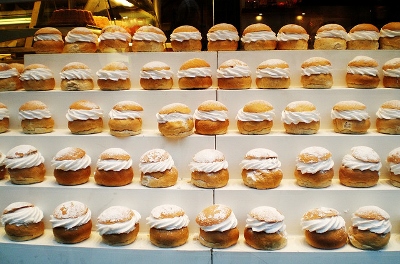Flickr/Pelle Sten
While Mardi Gras has come to be more synonymous with colorful beads than anything else, many countries around the world have special traditions that accompany the day before Ash Wednesday, the first day of Lent. In some countries, Shrove Tuesday is honored with pancakes, but in Sweden it’s all about the semla, a tasty pastry that has come to be an iconic Scandinavian treat around the world this time of year.
What is a semla?
Semlor are cream buns, made with a sweet, yeasty dough, filled with almond paste and topped with whipped cream. Traditionally eaten on Fat Tuesday—known as fettisdagen in Swedish—as a kick-off to Lent, nowadays any self-respecting Swedish café or bakery carries them from the beginning of January onwards through Easter. With a strong cup of coffee, is there of a better winter treat?
The history of semlor
The word semla actually comes from the Latin simila, which means wheat flour. In Sweden, a semla can also be called a fastlagsbulle, which is a word more commonly used in Southern Sweden. The debate over whether to call it a semla or a fastlagsbulle is so intense that there is even a Facebook group devoted to the discussion, titled Det Heter Fastlagsbullar (It’s Called Fastlagsbullar). Fastlagen is the time right before Lent, originally just the day before Lent, but now considered Sunday (fastlagssöndag), Monday (fastlagsmåndag) and Fat Tuesday (fettisdagen). Of course if you are a traditionalist, you will only eat a semla on these three days. But let’s be honest, it’s hard to say no to a bun filled with sweet almond paste topped with heavy whipped cream, isn’t it?
In the beginning, the semla was just your average bun with no filling—the first known semla appears in a painting from 1250, which hangs in a Danish church. Then in the 18th century, people started filling them with almond paste. Later, in the 19th century, they were served with warm milk, known as hetvägg in Swedish. This method of eating the Lent bun with milk, which people still do, wasn’t just common in Sweden—it happened around northern Europe; called hetweggen in German, hedevig in Danish, and heitevegg in Norwegian. As it happens, the last thing King Adolf Fredrik ate before passing away on February 12, 1771 was a hetvägg.

Flickr/gesternumdiesezeit
Get your own semla
Nowadays, the average Swede buys about five semlor from bakeries during the semla season, not taking into account all the semlor that are made at home. Fat Tuesday is, of course, the baked good’s holy day, when about 6 million of them are consumed in Sweden.
With the increasing popularity of Nordic cuisine, it’s no surprise that this delicacy has begun to pop up around the world. You can get one in cities around the world, from Los Angeles to Seoul to Sydney. But for those who don’t live close to a Swedish bakery—or an IKEA, which often carries them—making semlor at home is simple. It starts with a sweet, yeasted dough similar to a brioche and scented with cardamom. Then the top is cut off of each bun, the center is removed and the crumbs are mixed with almond paste and a little milk to create a thick filling that’s then placed back in the hollow of the bun. It’s topped off with heavy whipped cream, crowned with the reserved top of the bun, and a sprinkle of powdered sugar for an extra touch.

Flickr/Charlotta Wasteson
Semlor season comes but once a year, so while you should be sure not to overdo it, that is after all what Fat Tuesday is about. You have the rest of Lent to be more responsible with your baked good intake. Make a batch of these and feel like a Swede for a day. Be sure to brew a strong pot of coffee.
Anna Brones is the author of The Culinary Cyclist and Fika: The Art of the Swedish Coffee Break and runs Foodie Underground, a site about real food for real people. Wherever she is in the world, she can often be found riding a bicycle in search of excellent coffee.